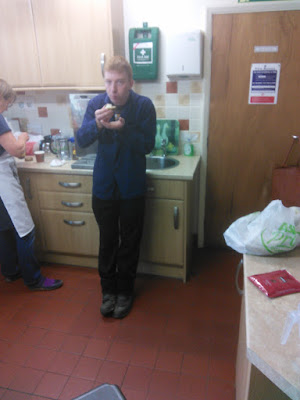Heatherslaw Mill sits on the river Till at a picturesque spot half way between the villages of Ford and Etal, Both villages show signs of serious historical wealth - like castles.
You can see a bit about the area, including some footage of the mill's waterwheel in action in this short video. Visiting Ford and Etal was a little like stepping into an episode of Midsomer Murders. I kept expecting to bump into a mad vicar on the village green.
The river Till feeds into the river Tweed and runs at a fairly relaxed pace. The mill doesn't have the benefit of a great drop in the height of the river like the Heron Corn Mill has. And unlike the river Bela which has lots of other streams feeding into it, the river Till picks up hardly any extra water on its way. So the mill has to make the most of the water it has, and the power it supplies.
But it may be a mistake to think of the river as a bit of a meandering stream. There are some frightening flood level marks in the ground floor of the mill, dating from 1948 and 1992. And the Mill pamphlet contains this poem -
Tweed said to Till:
'What makes you run so still?'
Till said to Tweed:
'Tho' ye run with speed
and I run slaw,
Yet where you drown ae man
I drown twa'.
Presumably that is where the "slaw" in Heatherslaw comes from - nothing to do with cabbage after all!
I tried to catch the Heatherslaw wheel, but without much success -
- Heron Corn Mill - breastshot wheel (these are the old buckets)
- Redbournbury Mill - overshot wheel
- Little Salkeld - pitchback wheel (like a reverse breastshot)
The stones are much smaller and do not have grooves.
In fact the miller has a clock that tells him when the barley has been polished enough. When the bell rings he has to stop polishing the barley. The clock doesn't tell the time, it counts the revolutions of the stones.
A second water wheel was added at Heatherslaw in 1770 and is still in place, although no longer working. When it was fully operational, each of the two wheels was fed by its own mill race.
The miller is a very approachable and chatty lady who is clearly well used to sharing her knowledge about the mill with the public. She told me that the waterwheels were originally external, and the building was later enlarged, enclosing the waterwheels. This sounds like the Heron Corn Mill, where Stuart says the wall on the inside of the waterwheel was originally the outside wall of the building, which was subsequently enlarged.
Much of the mill workings at Heatherslaw can be controlled from the working floor of the mill, like the sluice gate -
Some of the machinery at Heatherslaw is similar to that at the Heron Mill, like this sieve suspended on moving belts -
You can see the central shaft going up from the main gears on the bottom floor to the top of the mill. and the flour to be sieved is coming down into the sieve from the top of the mill.
We have something very similar to this at the Heron Corn Mill -
There has been at least one mill at Heatherslaw since 1300, and a document of 1376 talks about a "new water-mill". Like the Heron Corn Mill, Heatherslaw has long had another mill facing it on the opposite side of the river. About the same time as the second waterwheel was installed in the corn mill, a forge mill was built on the other side of the river, to produce farm implements.
The forge mill is long gone, and in recent times a narrow gauge railway has grown up on the other side of the river. This is very good for the mill, as it brings in lots of visitors who get two attractions for the price of one as it were. We took a very pleasant return trip to Etal village on the train before visiting the mill. At times it felt like the train could hardly make it up the hill, but it got there in the end. The gentle pace gave us plenty of time to take in the delightful countryside, and watch a heron on the river. There is nothing to beat the smell of smoke on a nice summer's day!
We could do with one of these donations boxes - very natty!
At Heatherslaw the same effect is achieved with a jack. Much safer!
Heatherslaw Mill processed oats, like Heron Corn Mill, and had a kiln to dry the grain. But the Heatherslaw kiln is much smaller and altogether different from the Heron's. The oats sat over a small fire, and were turned by a rotating blade, driven from above.
We had a nice day when we went to Heatherslaw. One of the best things was that we were able to take some flour home with us. I would recommend it to you if you are visiting Northumberland.















































